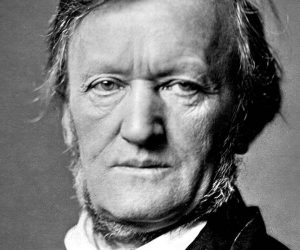Book Review: Alex Ross’s Dizzying, Engrossing, and Sometimes Overwhelming Exploration of Wagnerism
By Jonathan Blumhofer
For critic Alex Ross, Wagnerism is as profound and far-reaching an aesthetic ideology — for good, ill, and all degrees in between — as any.
Wagnerism: Art and Politics in the Shadow of Music by Alex Ross. Farrar, Straus and Giroux, 740 pages, $40

It’s fitting that Alex Ross’s latest book, Wagnerism, is both his longest and most narratively complex. A survey of the singular influence of the composer Richard Wagner’s music and ideas on the culture and politics of the West during the last century-plus, it’s a work of conspicuous breadth as well as cross-disciplinary synthesis.
As Ross notes, Wagnerism — the posthumous cult that emerged to carry on Wagner’s aesthetic and philosophical ideas — is a tricky subject to pin down: its definitions seem to multiply the more one focuses on its particulars. Even so, Wagnerism encompasses the arts (literature, visual art, theater, dance, architecture, and film) as well as politics.
That Wagner was far more than just a composer helped expand his reach: he was a dramatist (writing his own opera librettos), essayist, polemicist, theater director and innovator, as well as a popularizer of what Ross describes as the “pseudoscientific…antisemitism” that figured prominently in certain realms of late-19th- and 20th-century European politics. Tracing the outward influence of his ideas — particularly Wagner’s writings on Gesamtkunstwerk (“total artwork”), use of leitmotifs, concepts like “endless melody” and “artwork of the future,” along with the mix of probing psychology and spectacular action sequences that recur in his mature operas — forms the core of this book.
Given the breadth of his work and influence, then, it’s not surprising that Wagnerism’s shape took different forms in different places and at different times.
In France, for instance, after the 1861 Paris premiere of Tannhäuser, Wagnerism became synonymous with some of the leading literary and visual artists of the day: poets Charles Baudelaire and Judith Gautier, as well as the writer August Villiers, counted among Wagner’s prominent admirers, while Vincent van Gogh raved about Wagner’s “art of consolation for broken hearts” in a letter to Paul Gauguin.
In Victorian England, Wagner’s reception was complicated by his anti-Semitism (also by his vilification of the Queen’s favorite composer, Felix Mendelssohn) and the reputations of some of his operas (the first to be staged complete in London was The Flying Dutchman, only in 1870). Yet by the time of Wagner’s death in 1883, an enthusiastic British Wagner following had developed, partly thanks to a belated embrace of the composer by English writers, as well as the support of public figures like the Prince of Wales (the future King Edward VII) and William Gladstone.
Wagner’s reception in the United States was aided by the country’s then-large German immigrant population (which, coincidentally, comprised a large percentage of the nation’s professional musicians). His ensuing influence was wide-ranging: Ross points to the work of poet Sidney Lanier, writer Owen Wister, and artist Albert Pinkham Ryder as being seminal in the merging of American and Wagnerian influences in the arts. He also includes a fascinating discussion of Wagnerism’s significance in the development of the architectural philosophies of John Root, Daniel Burnham, and Louis Sullivan.
Of course, Wagnerism operated in more abstracted realms, too, and Ross visits its role in late-19th-century mysticism; its perhaps paradoxical place in the lives and work of Theodor Herzl, Otto Weininger, and W.E.B. Du Bois (among others); as well as its function as a totem in turn-of-the-century feminist and gay culture. Most tantalizing is Ross’s recounting of the tale of Luranah Aldridge, who almost became the first Black singer to appear at Bayreuth: Wagner and Wagnerism, it seems, could truly be all things to all peoples.
As for Wagnerism’s effects on the world of literature and philosophy, Ross discusses the usual suspects, starting with Nietzsche’s tumultuous relationship with the composer and Thomas Mann’s heady, if hesitant, embrace of Wagner’s work and its themes. Most intriguing are a pair of chapters devoted, respectively, to less obviously Wagnerian writers Willa Cather, Virginia Woolf, and James Joyce.
Perhaps Wagnerism’s most remarkable service, though, is the judicious way Ross deals with Wagner, the Third Reich, and Hitler. To be sure, this is a complex topic that’s too often oversimplified. But in Ross’s hands, its skein of fact, myth, and contradiction unfold with astonishing lucidity and, impressively, few outright judgments (though the chapter’s closing scene, in which the US Air Force deposits a bomb through the roof of Wagner’s villa, Wahnfried, is perfectly placed).
A latter pair of chapters discuss Wagnerism’s postwar resuscitation, particularly its influence on cinema and other visual arts.
What, then, to make of Wagnerism as it presently stands? While inextricably tied to his life and work, Wagnerism is now (and perhaps always was) about far more than just Richard Wagner. Even so, it reflects aspects of his character at just about every turn.

Composer Richard Wagner. Photo: Wiki Commons.
As a kind of movement, Wagnerism is riven by anomalies and inconsistencies: the recurring ambivalence — and sometimes outright hostility — of German audiences to some of Wagner’s music, for instance, is one of the book’s more ironic leitmotifs.
Its pull fluctuates. For some of Ross’s subjects (like the film director Sam Mendes), Wagnerism seems less formative than for others. Also, being drawn into its orbit doesn’t guarantee one’s immortality: many acolytes (like the writer Joséphin Péladan) are now largely forgotten. Still, it’s allure has, often enough, proven irresistible.
Indeed, Ross’s concern for simply documenting the phenomenon in such detail lends the text its sprawling air. But that’s surely his prerogative: viewed this way, Wagnerism is as profound and far-reaching an ideology — for good, ill, and all degrees in between — as any. Its lasting vitality can be chalked up to the most fundamental of reasons. As Ross writes in a closing “Postlude,” we see in Wagner and his influence nothing less than “the highest and lowest impulses of humanity.”
That’s a big claim, but not too wide of the mark. Wagnerism’s contradictions are often stark: how could the ideas and work of a single man have so affected the creative and intellectual worldviews of the likes of Baudelaire, Paul Cézanne, Herzl, Hitler, Luis Buñuel, and Anselm Kiefer? Investigating that question, even more than conclusively answering it, is the reward of this dizzying, engrossing, sometimes overwhelming — or, to use another word, Wagnerian — book.
Jonathan Blumhofer is a composer and violist who has been active in the greater Boston area since 2004. His music has received numerous awards and been performed by various ensembles, including the American Composers Orchestra, Kiev Philharmonic, Camerata Chicago, Xanthos Ensemble, and Juventas New Music Group. Since receiving his doctorate from Boston University in 2010, Jon has taught at Clark University, Worcester Polytechnic Institute, and online for the University of Phoenix, in addition to writing music criticism for the Worcester Telegram & Gazette.
